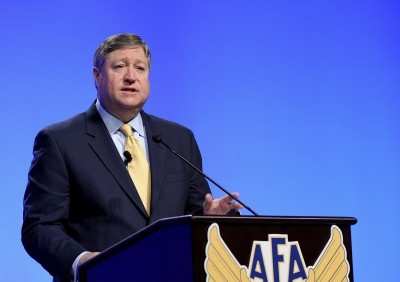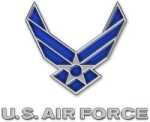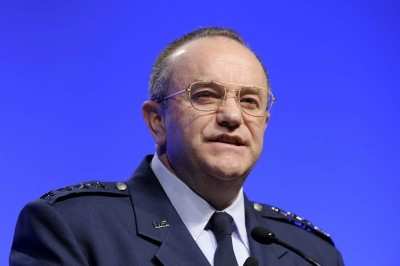Vice CSAF: Air Force Must Prepare For More Complex, Varied
Ops
During remarks to the Air Force Association's 27th Annual Air
Warfare Symposium and Technology Exposition in Orlando, Florida
Feb. 18, the Air Force's senior ranking official reviewed the
service' s priorities and underscored Air Force commitment to
making the most of available resources in a challenging fiscal
environment.

Air Force Secretary Michael Donley (above) spoke at the AFA
event a day after he and Air Force Chief of Staff Gen. Norton
Schwartz testified before the House Armed Services Committee in
Washington, D.C., on the Air Force's current posture and fiscal
2012 budget. Addressing an audience of approximately 300 AFA
members, defense industry officials, and U.S. military
representatives, he said that he and General Schwartz noted a
"distinctly different budget climate this year" in light of new
fiscal restraints. "Congress has begun a serious and what is likely
to be a protracted debate over our national debt, persistent annual
budget deficits and priorities in the federal budget," Secretary
Donley said. "If there were any doubt that defense would be part of
that debate, I think that doubt was erased this week."
In this context, he characterized Defense Secretary Robert
Gates' mandate for the services to find more than $100 billion in
internal savings and efficiencies as "more than prescient",
enabling Department of Defense officials to shift these savings
from lower priority "tail" to warfighting "tooth" over the Future
Years Defense Plan. Toward this effort, Air Force officials have
identified $33 billion in savings and efficiencies they can
redirect into high priority programs. Despite reduced
personnel, aging equipment and a leaner budget, they are continuing
their imperative to get the most out of all the resources the
service provides, said Secretary Donley. "This is not
sloganeering," he said. "We are absolutely committed to
implement the efficiencies now planned. We recognize that some may
yield less than we projected, some may yield more. But we will stay
after it and continue to look for additional opportunities for
savings and efficiencies going forward."
Donley said the Air Force's priorities include strengthening the
Air Force nuclear enterprise; partnering with the joint and
coalition team to win today's fight; developing and caring for
Airmen and their families; modernizing air and space inventories,
organizations, and training; and recapturing acquisition
excellence. Addressing these priorities is an ongoing, multi-year
effort, the secretary said. "We continue to strengthen the nuclear
enterprise; we'll provide safe, secure, and effective combat ready
forces for nuclear deterrence and global strike operations," he
said, adding that management and oversight of nuclear
weapon-related material involves sustaining and upgrading systems
and managing human capital.

He also said partnering with the joint and coalition team to win
today's fight has been fundamental to successes in both Iraq and
Afghanistan over the past year. "With nearly 34,000 Airmen deployed
to contingencies across the globe, and 28,000 supporting the fight
from 63 locations in U.S. Central Command, we've supported the
joint and coalition team with more than a half million hours flown
in theater in the last year, averaging more than 400 sorties a
day," Secretary Donley said. "We remain as committed as ever to
providing the global vigilance, reach and power that enabled a
successful transition in Iraq from combat operations to a 'train,
equip and support' role and the surge in Afghanistan."
On the vigilance side of the equation, the secretary said that
as demand for intelligence, surveillance and reconnaissance
continues to grow, Air Force officials are aggressively evolving
the ISR capability to support combat operations. He said the
service will also take a closer look this year at how best to size
and balance the full portfolio of ISR assets in the future. "In
active response to today's urgent operational needs, in pushing
forward additional breakthroughs in new technology using rapid
acquisition processes, and fueled by supplemental appropriations,
we have developed a wide range of new ISR sensors and platforms,"
the secretary said. "As resources diminish, we need to rationalize
this work and develop a balanced portfolio for the future."
The secretary concluded with his intention to keep the Air
Force's most critical asset at the forefront. "Our greatest
guarantor of success is our Airmen, and that's why developing and
caring for Airmen and their families is a priority," Secretary
Donley said. "Taking care of Airmen and their families is a
priority because it is on their shoulders that we prevail in
today's fights, that we will prevent and deter others and prepare
for the challenges of tomorrow," he said. "It will be their
insight, their innovation that will drive much of the way we
organize train, equip and operate to meet future challenges."

The Air Force Vice Chief of Staff, General Philip M. Breedlove
(above), told the gathering that the Air Force is working to
balance today's needs and tomorrow's challenges while operating
under intense fiscal pressures. He said the Air Force must remain
committed to the joint and coalition team, adaptable to an
ever-changing battlefield, and keener about acquisition in response
to a more restrained budget. "Our nation demands and relies on us
to fight across the full spectrum of conflict, not just the wars we
find ourselves in today," General Breedlove said. "We face static
or even declining real budgets, and certainly decreased purchasing
power, yet we have to be prepared across the entire spectrum of
operations."
The general said that this task will be increasingly daunting as
previous permissive budget environments, which enabled the Air
Force to buy advanced weapons systems and capabilities, become a
thing of the past. To better prepare for financial and battlefield
uncertainties, he said the Air Force must apply irregular warfare
lessons learned, normalize the career fields most strained by
today's fight, and recapitalize its most stressed platforms. "We've
ramped up remotely piloted vehicle orbits from one in 2001 to 48
today," General Breedlove said. "We've given eyes to the ground
commander that they never anticipated, and eyes that they cannot
now live without."
General Breedlove said remotely piloted aircraft and other
platforms supporting the joint and coalition team overseas are so
critical to the current fight that they have been at surge rates
for years. "Our remotely piloted aircraft operators have had
assignments extended, leaves canceled, and test and training
sorties foregone in order to fly and fill our combat requirements,"
the general said. "We'll need to incorporate these capabilities to
a more normalized air expeditionary force structure, one that
brings more predictability to our Airmen's lives."
General Breedlove lauded the "inherent flexibility and
adaptability" of airpower and Airmen, as seen in today's irregular
warfare.
 True Blue Power and Mid-Continent Instruments and Avionics Power NBAA25 Coverage
True Blue Power and Mid-Continent Instruments and Avionics Power NBAA25 Coverage ANN's Daily Aero-Term (10.15.25): En Route Automation System (EAS)
ANN's Daily Aero-Term (10.15.25): En Route Automation System (EAS) Aero-News: Quote of the Day (10.15.25)
Aero-News: Quote of the Day (10.15.25) ANN's Daily Aero-Linx (10.15.25)
ANN's Daily Aero-Linx (10.15.25) NTSB Final Report: Jeremy S Lezin Just SuperSTOL
NTSB Final Report: Jeremy S Lezin Just SuperSTOL





